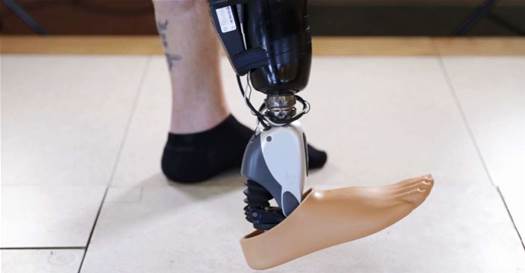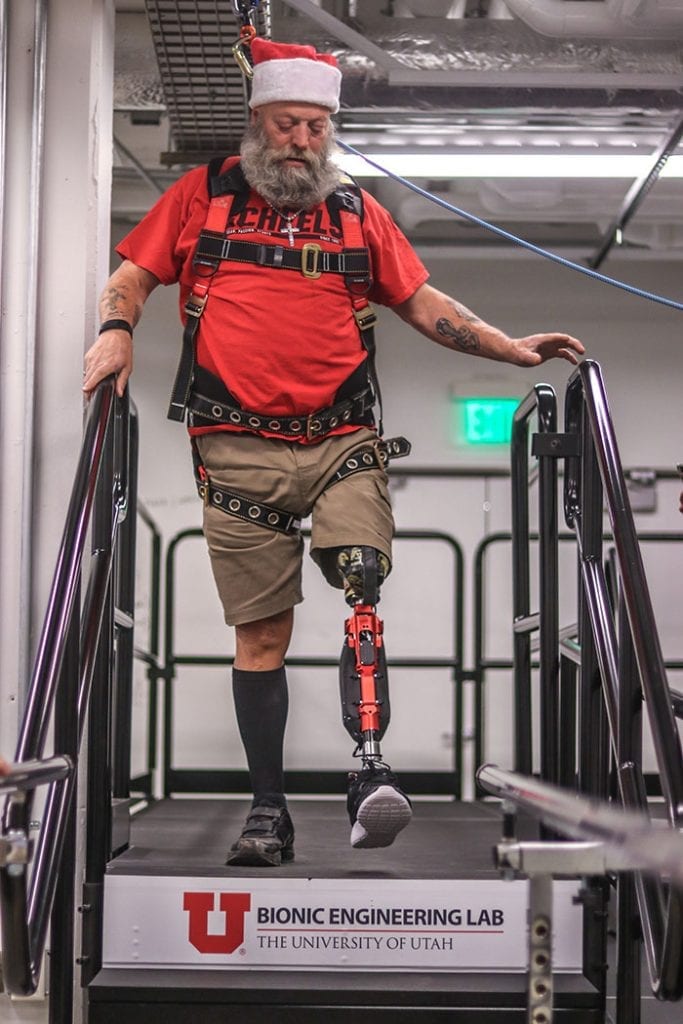
via OSSUR
NO, REALLY. AMPUTEES HAVE BEEN TESTING THEM FOR OVER A YEAR
For a full decade, Gudmundur Olafsson was unable to move his right ankle. That’s because it wasn’t there. Olafsson’s amputated lower leg was the delayed casualty of an accident from his childhood in Iceland, when he was hit by an oil truck. “I lived in pain for 28 years,” says Olafsson. “After 50-plus operations, I had it off.” For years after the operation he wore a Proprio Foot, a prosthetic with a motorized, battery-powered ankle, sold by the Reykjavik-based company Ossur. The Proprio is essentially a wearable robot, with algorithms and sensors that automatically adjust the angle of the foot during different points in its wearer’s stride. Olafsson’s ankle moved on autopilot.
But 14 months ago Ossur upgraded his hardware. Now, at age 48, Olafsson can move his right ankle by thinking about it. When the electrical impulse from his brain reaches the base of his leg, a pair of sensors embedded in his muscle tissue connect the neural dots, and wirelessly transmit that signal to the Proprio Foot. Since the command reaches the foot before the wearer’s residual muscles actually contract, there’s no unnatural lag between intention and action. That makes Olafsson part of a highly exclusive club. Along with David Ingvasson, a fellow Ossur tester, he’s one of the only people on the planet who owns a brain-controlled bionic limb. Ossur unveiled its implanted myoelectric sensor (IMES) technology today at an event in Copenhagen, and is now preparing large-scale clinical trials, in the hopes of reaching the market in three to five years.
“The first time, to be honest, I started to cry.”
This is a bigger breakthrough in the field of robotics and advanced prosthetics than it might appear. Brain-controlled bionic limbs make headlines on a regular basis, with the implication that the science has been solved, and experimental systems are already transitioning to products. But most of those devices are confined to laboratories, and many require complex surgery, such as transplanting muscle tissue or implanting electrodes in a subject’s brain. These devices look like the real thing in brief, sometimes compelling video clips. But so far, prosthetics that respond to thoughts are not so much a reality as a promise.
Read more: Brain-Controlled Bionic Legs are Finally Here
The Latest on: Brain-Controlled Bionic Limbs
[google_news title=”” keyword=”Brain-Controlled Bionic Limbs” num_posts=”10″ blurb_length=”0″ show_thumb=”left”]
via Google News
The Latest on: Brain-Controlled Bionic Limbs
- How the brain's arousal center helps control visual attention tooon May 1, 2024 at 5:00 pm
Neuroscientists have artificially increased neuronal activity in part of the brain by briefly shining ... Optogenetics allows researchers to selectively control the activity of norepinephrine ...
- What to Know About Hemorrhagic Strokeon April 30, 2024 at 5:00 pm
Different areas of your brain control different functions. When a hemorrhagic stroke affects a specific part of your brain, functions controlled by that part of the brain will also be affected.
- Brain-machine integration spawns global biz raceon April 29, 2024 at 1:20 am
The bionic hand was developed by BrainCo ... with over 100,000 units of high-precision single-item brain-machine interfaces, which means we are able to control the cost of such frontier technology and ...
- Enter Robots: Are We Ready?on April 25, 2024 at 11:09 am
For example, robotic prostheses attached as substitute limbs can grant ... Eventually, the brain-computer interface (BCI) will give patients increasing control of these bionic parts.
- Enter Robots, Are We Ready?on April 24, 2024 at 5:00 pm
For example, robotic prostheses attached as substitute limbs can grant ... Eventually, the brain-computer interface (BCI) will give patients increasing control of these bionic parts.
- Brain's Cerebellum Could Help Direct Prosthetic Limbson April 16, 2024 at 12:35 am
TUESDAY, April 16, 2024 (HealthDay News) -- Tapping the power of the small brain region called the ... This technique has allowed patients to control robot limbs, motorized wheelchairs and ...
- Discover How Your Brain Builds Muscle Memoryon April 14, 2024 at 5:00 pm
Note the cerebellum on the illustration of the brain above. What does that area of the brain control? Credit: Shutterstock Another cool thing about the brain is that aerobic exercise, such as walking, ...
- Boosting the brain's control of prosthetic devices by tapping the cerebellumon April 14, 2024 at 5:00 pm
Neuroprosthetics, a technology that allows the brain to control external devices such as robotic limbs, is beginning to emerge as a viable option for patients disabled by amputation or ...
- How to control the spiral of the overwhelmed brainon April 10, 2024 at 2:00 am
The weight of these multiplying roles and changes in brain function mean we need to start taking more care of ourselves as we age and how we live day to day has to change. I spoke to the ...
- Types of Paralysison April 7, 2024 at 5:00 pm
Motor neurons are the nerve cells that control the muscles you use to walk, breathe, speak, and move your limbs. There are two types: upper motor neurons, which send signals from your brain down ...
via Bing News










